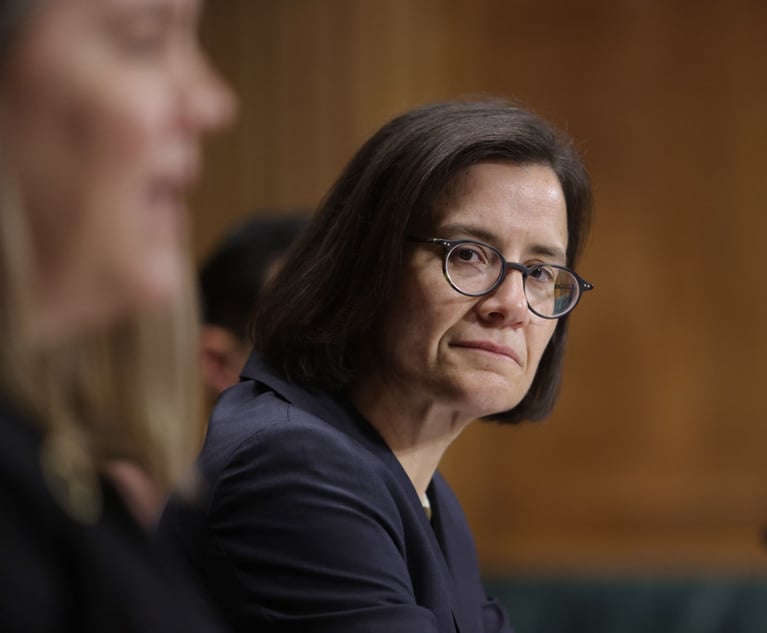The Law Firm Disrupted: The Next Wave of In-House Tech Is Already Here
What the advent of contract analytics could mean for the future function of corporate legal departments.
February 08, 2018 at 09:00 PM
6 minute read
This week, we dive into the buzz of AI and try to find out why in-house leaders are optimistic about the potential for “contract analytics.”
Your reactions to this discussion (flattery preferred) can be directed my way at [email protected].
As an assistant general counsel at DirecTV Latin America from 2003 to 2005, Laurie Brasner was in charge of a monumental legal task to help the company emerge from bankruptcy amidst a sale of its parent company.
The effort involved finding the company's financing agreements—often in a what-filing-cabinet-are-they-in sense—and studying what provisions might be affected by the ongoing Chapter 11 proceedings. All in a race against the clock.
“It gave me the experience to say there has got to be a better way of doing what we're doing,” Brasner said.
About 15 years later, the technology to do that job in a couple days is just now catching on among Brasner's general counsel counterparts.
What are known as contract analytic tools are something like a corporate corollary to what e-discovery has done for litigation. But like most technologies in the legal field, such “AI-enabled” contract analytic tools have been adopted by relatively few in-house legal departments, although there are signs that may quickly change.
Brasner is helping to lead the charge as general counsel of Seal Software, a contract discovery and analytics provider that counts as clients Aetna, Deloitte, Experian, Kaiser Permanente, Merck & Co. Inc., PayPal, Salesforce and others.
Seal claims its software, which uses the “AI” tag, can shave 70 to 80 percent of the time required to extract and review corporate documents. Seal competes with a handful of companies including Apttus, Kira Systems and Luminance.
A survey of law departments released this week by HBR Consulting states that 57 percent of in-house teams have not yet started exploring how AI-based tools could help them. A mere 6 percent had implemented one already, while 14 percent said they are aware of a “potential use case” but have yet to test it.
But by asking about generic “AI” tools, the survey's tepid response may be a sign that hype around the term has died down, not that GCs are uninterested in new technologies. When asked to narrow down what type of AI-assisted task has the most potential, 40 percent of respondents said contract analytics. That seems to gel with what 71 percent of respondents said they wanted from AI products: increasing productivity without increasing head count.
“The only way to really address that is to get cheaper people who can work faster, which generally doesn't work out very well, or leverage technology,” said Bobbi Basile, a managing director at HBR Consulting.
Basile predicts a “heavy uptick” in adoption of contract analytics tools in legal departments within the next two years.
What will that mean for the in-house lawyers? She doesn't predict an end to their jobs, but said technology will be like “an exoskeleton” that helps them provide better services to their ultimate clients, the business.
Pushing on the other side of the scale is a greater demand for in-house legal services caused by increasing regulation, said Seal's vice president of solutions, Christina Wojcik. Using contract analytics software, companies can much more quickly understand how they are impacted by things like Brexit or Europe's new General Data Protection Regulation.
“Some of the biggest companies in the world literally cannot find the most important documents that run their business,” Wojcik said. “Just having that centralized repository and the ability to run really simple searches is a game-changer.”
But there could be even greater efficiency down the line.
Wojcik said in the future contracts will be automated to a greater extent than today, so they will interact with various aspects of a company's infrastructure by themselves. Late payments on a new truck, for instance, could automatically trigger a letter sent to the owner, or a tow truck operator.
“It's a scary world for a lot of people,” Wojcik said. “But I've spoken on this topic on a number of occasions, and I always say the robots, right now, come in peace. But I can't predict when the time will come where it really will have an impact.”
As in-house legal departments become more efficient, they become even bigger competitors for legal work with outside law firms.
Roy's Reading Corner
On the bright side: Citi Private Bank's Law Firm Group said last year was better than 2016 for law firms. Revenue grew 4.5 percent from 2016 and profits per equity partner rose 4.8 percent. Even demand registered above zero, coming in at 0.7 percent growth in hours billed from the year prior. Take the positive where you can: In 2016, demand rose a mere 0.1 percent.
Even so, the report states that the legal market continues to favor the largest firms. While 68 percent of Am Law 50 firms said they had positive demand growth, only half of the Am Law 51-100 firms reported positive demand, while 40 percent of Am Law Second Hundred firms experienced growth in billable hours.
From Citi's report on The American Lawyer: “While we expect 2018 to be another year of mid-single-digit revenue and PPEP growth for the industry, what remains to be seen in this dispersed and volatile market is whether the largest firms will continue to pull away from other market segments. What's clear is that, size aside, this is a market that will continue to favor firms who build strong brands, nurture client relationships and adapt their talent models to keep up with an evolving legal services market.”
Which brings us to: Merger madness. Citi said the increased volatility and dispersion in the legal market will lead to continued consolidation this year.
The headlines tell the tale. Clark Hill is in tie-up talks with Strasburger & Price. Foley & Lardner and Gardere Wynne Sewell appear headed towards a merger in April. And my colleague Christine Simmons reports that leaders of Hunton & Williams and Andrews Kurth Kenyon have signed off on a deal that partners will vote on shortly.
As The American Lawyer begins reporting on individual firms' finances from 2017, potential combinations looming on the horizon are sure to be a focus.
The Year 2023: Alicia Ryan, knowledge and innovation delivery manager at Fenwick & West, writes in The Artificial Lawyer about two hypothetical companies and how they receive legal services in the year 2023. It is a fun, easy-to-read narrative of how legal services could change and become much easier for clients to interact with. And be sure to read through to the end for the twist.
That's it for this week. Thanks for reading. Email [email protected] with thoughts on the content of this briefing.
This content has been archived. It is available through our partners, LexisNexis® and Bloomberg Law.
To view this content, please continue to their sites.
Not a Lexis Subscriber?
Subscribe Now
Not a Bloomberg Law Subscriber?
Subscribe Now
NOT FOR REPRINT
© 2025 ALM Global, LLC, All Rights Reserved. Request academic re-use from www.copyright.com. All other uses, submit a request to [email protected]. For more information visit Asset & Logo Licensing.
You Might Like
View All
Global Lawyer: Big Law Walks a Tightrope But Herbert Smith Freehills Refuses to Lose Its Footing
8 minute readTrending Stories
- 1Eliminating Judicial Exceptions: The Promise of the Patent Eligibility Restoration Act
- 2AI in Legal: Disruptive Potential and Practical Realities
- 3One Court’s Opinion on Successfully Bankruptcy Proofing a Borrower
- 4Making the Case for Workflow Automation
- 5Copyright Infringement by Generative AI Tools Under US and UK Law: Common Threads and Contrasting Approaches
Who Got The Work
J. Brugh Lower of Gibbons has entered an appearance for industrial equipment supplier Devco Corporation in a pending trademark infringement lawsuit. The suit, accusing the defendant of selling knock-off Graco products, was filed Dec. 18 in New Jersey District Court by Rivkin Radler on behalf of Graco Inc. and Graco Minnesota. The case, assigned to U.S. District Judge Zahid N. Quraishi, is 3:24-cv-11294, Graco Inc. et al v. Devco Corporation.
Who Got The Work
Rebecca Maller-Stein and Kent A. Yalowitz of Arnold & Porter Kaye Scholer have entered their appearances for Hanaco Venture Capital and its executives, Lior Prosor and David Frankel, in a pending securities lawsuit. The action, filed on Dec. 24 in New York Southern District Court by Zell, Aron & Co. on behalf of Goldeneye Advisors, accuses the defendants of negligently and fraudulently managing the plaintiff's $1 million investment. The case, assigned to U.S. District Judge Vernon S. Broderick, is 1:24-cv-09918, Goldeneye Advisors, LLC v. Hanaco Venture Capital, Ltd. et al.
Who Got The Work
Attorneys from A&O Shearman has stepped in as defense counsel for Toronto-Dominion Bank and other defendants in a pending securities class action. The suit, filed Dec. 11 in New York Southern District Court by Bleichmar Fonti & Auld, accuses the defendants of concealing the bank's 'pervasive' deficiencies in regards to its compliance with the Bank Secrecy Act and the quality of its anti-money laundering controls. The case, assigned to U.S. District Judge Arun Subramanian, is 1:24-cv-09445, Gonzalez v. The Toronto-Dominion Bank et al.
Who Got The Work
Crown Castle International, a Pennsylvania company providing shared communications infrastructure, has turned to Luke D. Wolf of Gordon Rees Scully Mansukhani to fend off a pending breach-of-contract lawsuit. The court action, filed Nov. 25 in Michigan Eastern District Court by Hooper Hathaway PC on behalf of The Town Residences LLC, accuses Crown Castle of failing to transfer approximately $30,000 in utility payments from T-Mobile in breach of a roof-top lease and assignment agreement. The case, assigned to U.S. District Judge Susan K. Declercq, is 2:24-cv-13131, The Town Residences LLC v. T-Mobile US, Inc. et al.
Who Got The Work
Wilfred P. Coronato and Daniel M. Schwartz of McCarter & English have stepped in as defense counsel to Electrolux Home Products Inc. in a pending product liability lawsuit. The court action, filed Nov. 26 in New York Eastern District Court by Poulos Lopiccolo PC and Nagel Rice LLP on behalf of David Stern, alleges that the defendant's refrigerators’ drawers and shelving repeatedly break and fall apart within months after purchase. The case, assigned to U.S. District Judge Joan M. Azrack, is 2:24-cv-08204, Stern v. Electrolux Home Products, Inc.
Featured Firms
Law Offices of Gary Martin Hays & Associates, P.C.
(470) 294-1674
Law Offices of Mark E. Salomone
(857) 444-6468
Smith & Hassler
(713) 739-1250












